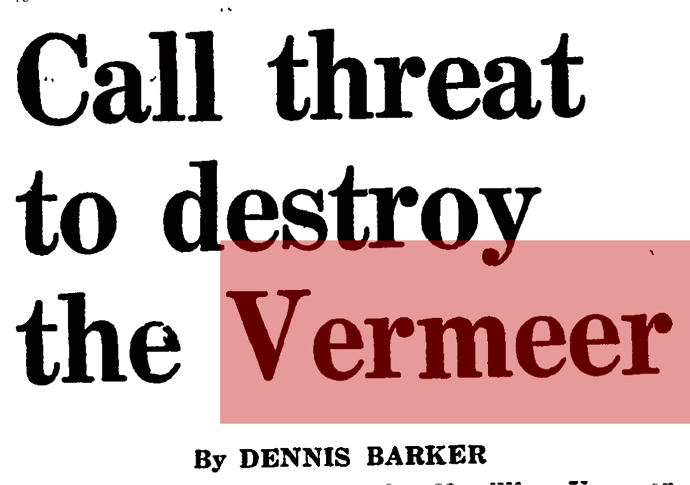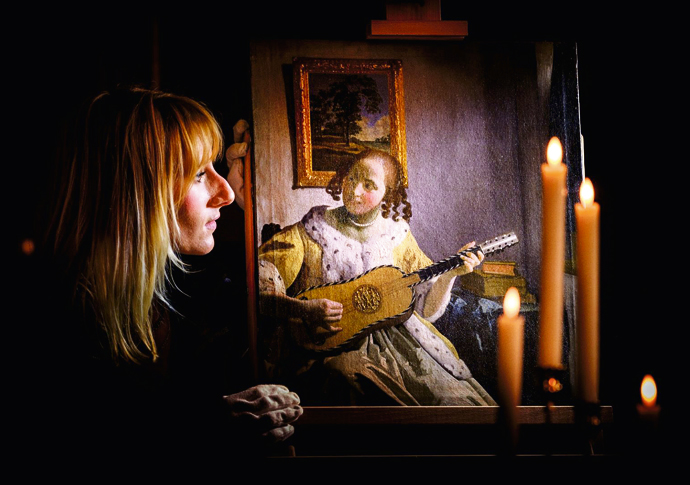50-year art theft mystery: How Uncle David stole £3m Vermeer
Nephew reveals how window cleaner relative took famous painting
Friday, 4th July — By Tom Foot

David Knight prompted press speculation
A 50-YEAR mystery of how a priceless painting was “kidnapped” from Kenwood and returned in a cemetery in Islington has been revealed by the thief’s nephew.
Paul Hodgson told the Tribune how his uncle had admitted to looting Johaness Vermeer’s The Guitar Player in 1974 from the mansion house close to Highgate.
The story of how David Knight stole the painting – and led detectives on a merry dance that included a psychic medium – is part of a TV comedy drama series in production.
The series will tell the colourful life story of the window cleaner, who was jailed after being framed for a major diamond heist a decade earlier. He came out of prison an accomplished criminal and went on to steal the Vermeer before leaving it for police in a burial ground at St Bartholomew the Great in Smithfield, his nephew said.

Press speculation
“The Vermeer was obviously the biggest thing he ever took,” Mr Hodgson told the Tribune. “David told me all about it several times, when I was young and when I was older.
“It was by a window on the ground floor and he just smashed that, cut the phone wires so they couldn’t call the police, reached in and got it. And then he went off down the hill.”
Mr Hodgson added: “It was worth a lot of money, but the problem with priceless paintings is that they are so famous they cannot be sold. It’s like they’re worthless – so he thought he’d have some fun with it.”
The newspaper clippings from the time show the finger being pointed at IRA terrorists, and then black rights activist groups in Grenada – but the real culprit was British born and bred.
“One of the best parts of it is how the police panicked,” Mr Hodgson said. “Normally they would just pick up any old ‘Herbert’, some patsy, and that would be that. But with this they had to find the painting too. They got a psychic medium involved in the investigation, who helped them find the frame but then led them on a wild-goose chase.”
The clairvoyant here was Nella Jones who, whether you believe in such talents or not, provided a tip that led them to finding the painting’s frame in the picturesque lake at Kenwood.

Vermeer’s The Guitar Player was ‘kidnapped’ by David Knight [English Heritage]
She insisted the location had come to her while watching a report on TV, and had immediately sketched out a map.
Ms Jones – known in the press as “witchie-poo” – went on to form a lasting relationship with the Met and would spend 20 years aiding them in investigations of murders and other serious offences.
Security had been tightened at Kenwood following the theft of another of the artist’s works two years earlier from an exhibition in Brussels and there was an alert telephone line which went straight to police.
“We are looking for either a master thief or a madman,” said a spokesman for Scotland Yard at the time.
The Guitar Player had been valued at up to $4.5million – but art historians had described it as “priceless due to its immense artistic importance”.
It had originally been donated to the Greater London Council by Lord Iveagh, a member of the Guinness family.
The archives show how Illtyd Harrington, the then deputy leader of the Greater London Council, was at the time facing questions about whether the state would pay any ransom demands to get it back.

Paul Hodgson and Richard Carroll
“I am not offering half-a-million to anybody,” said Mr Harrington. Mr Knight is believed to have cut a deal with the police to return the painting in exchange for a suspended sentence after being charged with a separate, much smaller crime – leading to the movie-like drop-off in the graveyard.
The full story of how Mr Knight was framed for the theft of the Colenso Diamond from the Natural History Museum in what is widely considered to be a miscarriage of justice can be read on Islington Tribune’s recently launched Substack subscription service.
Although the 133-carat diamond, donated to the museum by poet John Ruskin, was never found, Mr Knight spent three years in prison protesting his innocence.
World in Action later exposed how the detectives who claimed he had made a “verbal confession” were themselves jailed for falsifying evidence.